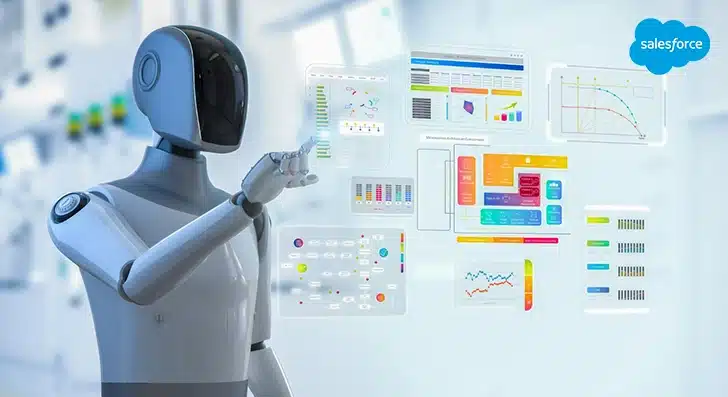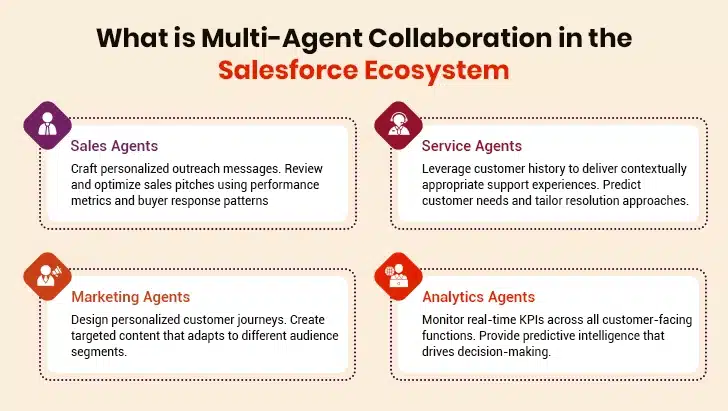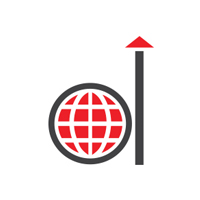Artificial intelligence (AI) is evolving beyond isolated, single-purpose tools. Today, we have sophisticated AI agents that can perceive their environment, reason, and act on their own. Yet, complex real-world challenges demand far more than any single agent can deliver. So, how can enterprises orchestrate diverse AI capabilities to solve these problems?
This is where multi-agent AI systems in Salesforce come in. These agents are fundamentally changing how businesses tackle intricate workflows.
What makes these multi-agent systems powerful is their distributed intelligence. Salesforce agents work in parallel, each handling specific subtasks. This specialization allows them to handle complex, multi-step processes while clearing bottlenecks that slow down operations. These systems aren’t just experimental tools; they’re already managing most customer interactions in many businesses.
This blog talks about the rise of collaborative AI in enterprise operations and examines why Salesforce provides the perfect foundation for this shift. From single assistants to agents working in coordination, we’ll see how these systems are reshaping what’s possible in business automation.

Table of Contents
From Single AI Assistants to Collaborative AI Agents
What is Multi-Agent Collaboration in the Salesforce Ecosystem
Enterprise Use Cases: From Complexity to Coordination
The Salesforce Advantage: Why It is the Ideal Platform for Multi-Agent AI
Business Benefits of Multi-Agent AI
From Single AI Assistants to Collaborative AI Agents
AI tools have come a long way in the enterprise world. Basic digital assistants of yesteryear have evolved into sophisticated collaborative systems. The early versions could only handle predefined tasks, such as setting reminders or performing simple searches. Today’s AI landscape looks completely different.
1. The Evolution from Assistants to Agents
AI assistants and agents serve fundamentally different purposes. Think of assistants as reactive tools that follow your commands and need constant input. They understand what you say and perform tasks when asked. AI agents operate autonomously with much more independence. They can design their own workflows. They can use available tools without someone overseeing them. This distinction represents a shift in how AI functions in business settings.
2. The Power of Multi-Agent Systems
The real magic happens when these AI agents work together. A multi-agent system functions as a network of specialized AI entities that collaborate with users to support decision-making across the entire enterprise.
This collaborative approach beats single-agent systems in several ways:
- Modularity and Specialization: Each agent handles specific tasks. This reduces bottlenecks and maximizes output.
- Scalability: New agents can be added as your business needs grow.
- Enhanced Problem-Solving: Combined specialized agents solve complex problems more effectively than single agents.
- Fault Tolerance: If one agent fails, others keep working.
What is Multi-Agent Collaboration in the Salesforce Ecosystem

The Salesforce ecosystem has specialized AI agents working in perfect harmony across departments. These agents share data, context, and insights. Their interconnectedness helps create seamless experiences throughout the customer’s journey.
I. Sales Agents That Prepare Personalized Pitches
Salesforce’s AI-powered sales agents have changed how teams connect with prospects. These agents prepare tailored pitches using a combination of CRM data and external sources. Sales teams using these systems see a significant boost in win rates.
The Atlas Reasoning Engine, the autonomous AI system in Salesforce, makes these agents smarter over time through reinforcement learning. The result? The agents help teams handle complex questions and objections, backed by trusted business data. They also analyze sellers’ pitches and provide targeted feedback to improve messaging.
II. Service Agents That Resolve Tickets
Service agents in Salesforce do more than just answer questions. They use sentiment analysis and historical data to understand how customers feel and what they’ve experienced. This helps them resolve issues in a way that makes sense to each customer.
Service agents work best as a team. One agent might handle customer queries while another suggests products that fit the conversation. These systems maintain conversation threads across different channels. The result? Customers don’t need to repeat information when moving from chat to email or phone.
III. Marketing Agents that Align Campaigns with Sales Triggers
Marketing teams benefit from specialized agents that build end-to-end campaigns based on specific goals. These agents generate campaign briefs. They also design customer journeys and create content. This helps marketers save time and effort.
Today, teams can create campaigns that respond to sales triggers and customer actions. They can use advanced audience segmentation and predictive analytics to improve campaign performance in real time.
Top Real-World Applications of Salesforce Einstein AI
IV. Analytics Agents That Monitor KPIs and Recommend Course Corrections
Analytics agents constantly watch key performance indicators across sales, marketing, and service functions. These specialized agents can spot patterns and trends that humans might miss. This allows teams to fix problems before they affect business results.
Ryan Bezenek, vice president of IT, Ariat International, puts it well, “It’s about making connections through the data that you might not have made as a human being. AI has the uncanny ability to tease out things about the consumer you might never think about.”
Analytics agents communicate their findings to other specialized agents. This creates a continuous improvement loop. For example, when an analytics agent spots underperforming metrics, it can trigger recommendations for adjustments to marketing campaigns.
The true power of Salesforce multi-agent systems lies in teamwork. They break down silos company-wide, creating unified customer experiences. Each agent specializes yet contributes to the collective goals.
Build Your First AI Agent in Salesforce Using Agentforce
Enterprise Use Cases: From Complexity to Coordination
Multi-agent systems aren’t just theoretical concepts; they’re solving real business problems. Today, companies have moved beyond experimental pilots to full-scale implementations that tackle challenges that once required extensive manual work. The outcome? Improved efficiency, customer satisfaction, and revenue growth.
1. B2B Sales Coordination
B2B companies have pushed AI-powered sales development beyond simple automation. They are using agents to synchronize outreach activities. Companies implementing multi-agent AI SDRs (sales development representatives) are seeing improved conversions.
What makes these systems so effective? They don’t just react—they anticipate. These systems can:
- Monitor organizational attributes like product launches to predict customer needs
- Deliver real-time insights on buyer requirements and purchase timelines
- Create personalized outreach across channels while maintaining consistent messaging
Sales teams using these coordinated systems spend much less time on paperwork. They focus on tasks where human talent delivers the most value e.g., building customer relationships.
2. Customer Service Triage
Modern customer service teams deal with a large volume of tickets every day. They need to decide which tickets they should prioritize based on their potential impact and severity. A triaging system evaluates each request and routes it to the right person. However, manual triaging can be time-intensive. Smart triage systems with coordinated AI agents help tackle the issue.
AI-based triage systems automatically categorize and route incoming requests. As a result, the response time drops significantly. These systems also enable faster resolution of high-priority tickets during peak seasons. Not to mention the reduction in manual labor.
3. Revenue Operations
Revenue operations represent the most advanced use of multi-agent systems, as they need coordination between traditionally separate departments. Through these systems, sales, finance, and product teams automatically share insights. This eliminates the delays that typically plague cross-functional work. As a result, information flows freely: no need for endless meetings, emails, or status updates.
Companies that leverage AI for revenue intelligence can:
- Reduce churn by deeply analyzing customer behavior and sentiment
- Gain better customer insights from sales calls and meetings
- Forecast sales more accurately using CRM and email data
The Salesforce Advantage: Why It is the Ideal Platform for Multi-Agent AI
Why does Salesforce stand out as the perfect foundation for multi-agent AI? The answer lies in its architecture. It is a system built for cross-functional AI collaboration. This advantage becomes crystal clear when we examine the platform’s core components.
I. Einstein 1 Platform: Unified Data Layer for Agents to Access Shared Context
Einstein 1 Platform provides a unified data foundation where agents access identical customer information. This ensures consistency across every interaction. This shared context eliminates the knowledge fragmentation that typically plagues enterprise systems.
Data unification means agents pull data from the same source. This way, the decisions of marketing agents align with those of sales agents. This helps avoid conflicting outputs that occur when AI systems operate in isolation.
II. Data Cloud: Real-Time, Unified Customer Profiles
Data Cloud delivers what multi-agent collaboration needs most: comprehensive, real-time customer profiles. Unlike traditional systems that scatter customer data across departments, Data Cloud creates unified profiles that update instantly across touchpoints.
This real-time capability proves essential in scenarios where:
- Service agents need to know about recent sales interactions right away
- Marketing agents must respond to purchase signals without delay
- Analytics agents need current data to make accurate recommendations
III. Salesforce Flow: Orchestration Across Departments
Salesforce Flow facilitates connections between AI agents. It enables them to coordinate complex workflows spanning multiple departments. This orchestration layer allows for sequential agent actions, where one agent’s output automatically starts the next action in a logical sequence.
The best part? Flow lets non-technical teams design intricate multi-agent processes through visual interfaces. It makes advanced AI capabilities available to everyone in the organization.
IV. Einstein Copilot and Copilot Studio: Groundwork for Custom Multi-Agent Models
Einstein Copilot provides an interface where users interact with multi-agent systems. Salesforce Copilot Studio offers tools to build custom agents tailored to business needs. Through these tools, organizations can create Salesforce Einstein agents reflecting their unique processes rather than adopting generic solutions.
The true strength of Salesforce lies in how these components work together smoothly. Intelligent automation creates a complete ecosystem. Multi-agent AI in Salesforce can tap into unified data, coordinate cross-functional processes, and deliver consistent experiences regardless of the department the customer engages with.
From Service to Sales: How Einstein AI Agents Drive Smarter Customer Engagement
Business Benefits of Multi-Agent AI
Multi-agent AI delivers many business benefits that boost the bottom line. When companies deploy specialized agents across departments, they unlock value that siloed AI implementations cannot match.
1. Faster, More Accurate Decision-Making
What separates top-performing teams from the rest? Shared insights. Multi-agent AI in Salesforce ensures everyone uses the same, up-to-date information. Companies using AI-powered dashboards get real-time analysis that spots patterns, predicts trends, and offers clear next steps.
These systems cut through data complexity. They translate complex datasets into easy-to-follow recommendations. This helps teams grasp what the numbers mean.
2. Cross-Functional Process Automation
Smart automation across business functions creates efficient workflows that improve teamwork. Companies that automate tasks and data sharing remove bottlenecks. The payoff is substantial:
- Faster turnaround times
- Cost reduction for specialized processes
- Reduced human error in routine tasks like data entry
This unified approach boosts productivity. It also spurs innovation by ensuring all departments within an organization work toward shared goals.
3. Hyper-Personalized Customer Journeys at Scale
Personalization is essential for success in modern markets. Multi-agent AI helps businesses deliver targeted messages and experiences through in-depth customer data analysis. These systems go beyond surface-level customization; they use big data, predictive analytics, and machine learning to understand behavior, predict needs, and provide solutions quickly. Companies that offer personalized experiences see better customer engagement, stronger loyalty, and lower costs.
4. Higher Productivity Through AI-Augmented Workflows
Humans and machines working together produce better results than working alone. AI automation handles repetitive tasks. This allows employees to focus on creative and strategic work. Companies that add AI to their workflows see impressive gains in productivity. This partnership between humans and AI creates a more innovative, flexible workplace focused on value-driven work.
Getting Started: A Path to Implementation
Multi-agent AI doesn’t require you to start from scratch. Smart organizations take a measured, step-by-step approach that balances quick wins with future goals. Here’s how to begin your journey:
I. Start with High-Impact Processes
A pilot that targets specific, valuable processes brings the quickest returns. It’s wise to start with repetitive, time-consuming, or error-prone tasks like lead qualification, customer onboarding, or content moderation.
When picking your first target:
- Map existing workflows to identify friction points
- Select processes where success metrics are easy to track
- Confirm you have enough quality data to train agents
II. Identify Siloed Workflows That Can Benefit from AI Coordination
Implementations that bridge previously disconnected systems create tangible value. Businesses should choose workflows where AI agents can pull information from one business system and push updates to another. For example, an AI system could pull a new order from the CRM, check inventory levels in the warehouse system, and push a production request.
III. Use Einstein Copilot Studio to Create Domain-Specific Agents
Einstein Copilot Studio lets you build custom agents without extensive coding skills. Start by clearly defining what you want your agent to accomplish—specific tasks, target users, and desired outcomes. Then, gather high-quality data that reflects the interactions your agent will handle.
Don’t try to build one agent that does everything. Specialized agents focused on specific functions are easier to develop, test, and improve than do-it-all agents.
The key to success? Start small, test properly, and expand gradually. Begin with a single function, perfect it based on real-world performance, and add capabilities as you build confidence. This measured approach prevents costly missteps. It also allows your team to learn and adapt as they go.
The Future of Enterprise AI is Collaborative
There’s no denying that enterprises are seeing a shift from single AI tools to multi-agent systems. We’re moving from isolated assistants to interconnected teams of specialized agents that share context and coordinate actions across traditional boundaries. Salesforce provides the perfect foundation for these collaborative systems through its unified data, real-time customer profiles, and smart orchestration capabilities.
Multi-agent AI in Salesforce represents more than just another tech advancement; it marks a new chapter in how enterprises function. Companies embracing this shift will deliver better customer experiences while boosting operational efficiency. The future belongs to those who understand this simple truth: collaboration beats isolation every time in AI, as in humans.





